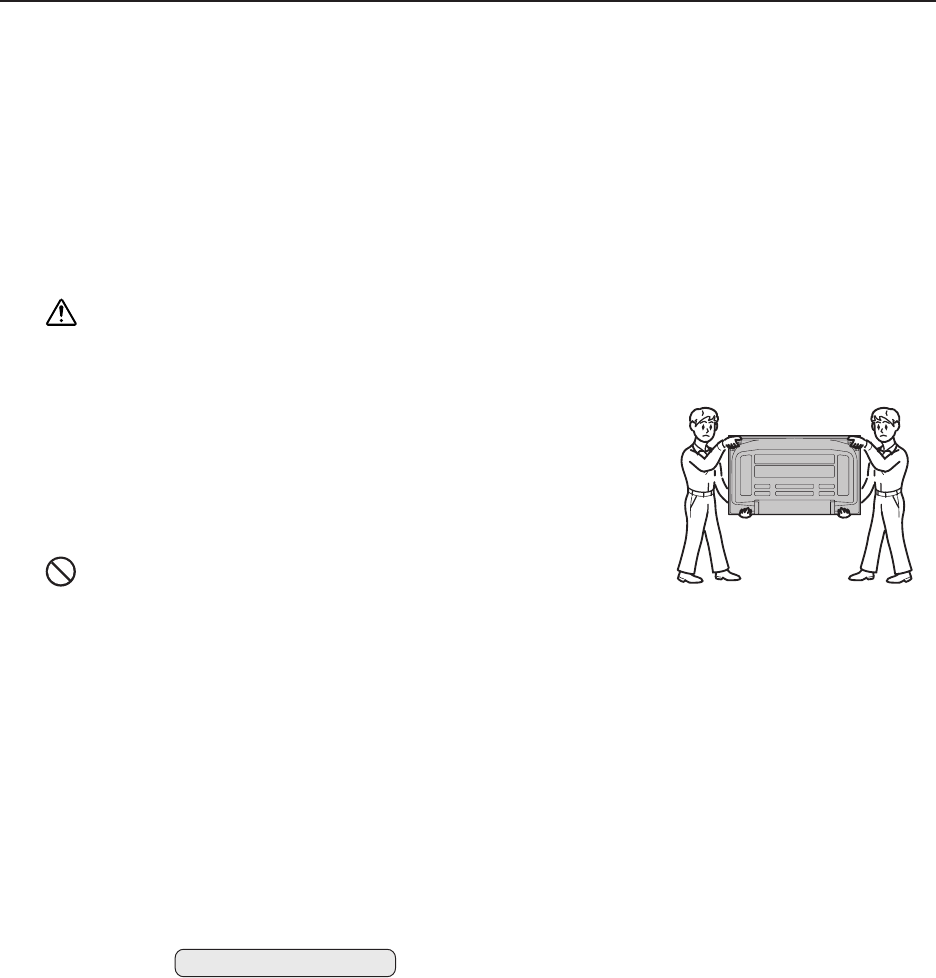
22
2) Unpacking procedures
1 Remove the packing bands.
2 Slowly lift and remove the upper carton.
3 Lift and remove the carton cover.
4 Remove the pads.
5 Remove the accessory and power cord cases.
6 Remove the unit (requires two or more people).
3) Transportation of the unpacked unit.
If it needs to be moved, the unit should be lifted by two or more people.
Caution
• Never move the unit by dragging it along the floor.
• Move the unit slowly, taking care to prevent scraping or striking the delicate
front protective panel.
• In order to prevent adhesion of dust, remove the protective film only after
all work and preparations for the installation site, including clean-up following
unpacking, are complete.
• When moving the display, it should always be carried by two people holding
the rear handles in the manner shown.
No!
Never attempt to move the Plasma Display by holding only one of the handles.
3.3.3 Re-packing (re-packing and re-shipping are not covered by the warranty)
If the unit needs to be re-packaged, observe the following guidelines.
• Refer to the unpacking instructions in section “3.3.2 Unpacking” (pg. 21, 22). Pack the unit by reversing the
unpacking procedure. There is a front and back to the miller mat. Place the shiny film surface facing out and the
soft surface facing in towards the display glass.
• Restore all accessories to their original locations. Secure with adhesive tape to prevent damage during
transportation.
• Do not re-package and ship if the packing material is damaged.
3.3.4 Wiring
1) Connecting the power cable
• Refer to the “ Power Cord Connection ” section in the operating instructions.
• For power source specifications, refer to “3.1 Installation Site Requirements, Section 11) Power requirements”
(pg. 16) earlier in this document.
2) Connecting signal cables
• Refer to the operating instructions shipped with the unit for information on how to connect a PC or audio
device.
• Precautions when using long connecting signal cables
-- Use coaxial cables. For video signals use 3 C-2 V cables for lengths up to 15 meters and 5 C-2 V cables for
lengths up to 30 meters. Because computer signals are more likely to degrade than video signals, even if the
cable is shorter than 15 m, the use of 5 C-2 V coaxial multi-cables (5BNC) is recommended. You can also
improve signal quality by minimizing cable length.
-- Video cables plugged into video inputs and outputs close to dimmers, neon signs, air-conditioning units, or
cables for wired broadcasts may occasionally corrupt images.
3) Processing wires
• For permanent or long-term installation, please select cables of the correct length and consider the entire wiring
route. This is not as important for temporary or short-term installations such as at special events.
• Arrange and secure cables so that they are not subject to pinching or physical force. For temporary installations,
securing cables with string is adequate. For permanent installations, secure by more reliable means.
Installation Procedures


















